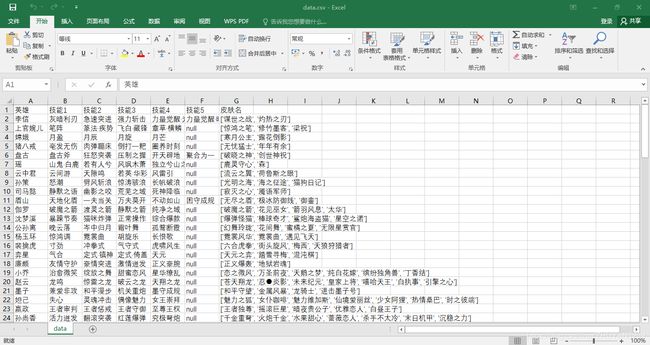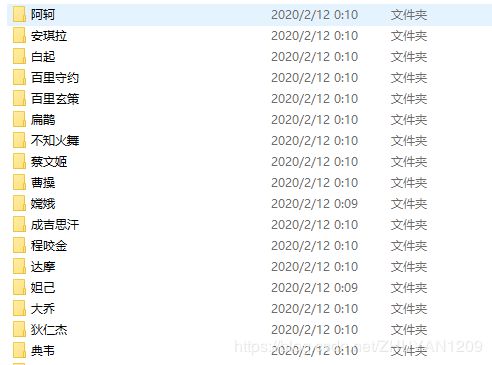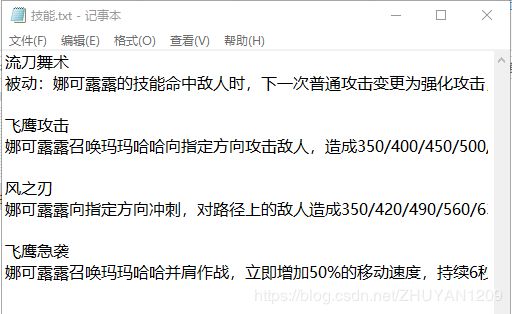python-scrapy爬虫框架爬取王者荣耀英雄皮肤图片和技能信息
1.创建工程
将路径切换到想要保存爬虫项目的文件夹内,运行scrapy startproject WZRY新建一个名为WZRY的工程。
2.产生爬虫
将路径切换至新创建的spiders文件夹中,运行scrapy genspider wzry "https://pvp.qq.com/",wzry是产生的爬虫名,"https://pvp.qq.com/"是要爬取的域名。
3.具体实现
3.1 item.py
列出想要爬取的数据信息
import scrapy
class WzryItem(scrapy.Item):
# define the fields for your item here like:
hero=scrapy.Field()
skins=scrapy.Field()
skill1=scrapy.Field()
skill1_detail=scrapy.Field()
skill2=scrapy.Field()
skill2_detail=scrapy.Field()
skill3=scrapy.Field()
skill3_detail=scrapy.Field()
skill4=scrapy.Field()
skill4_detail=scrapy.Field()
skill5=scrapy.Field()
skill5_detail=scrapy.Field()
image_urls=scrapy.Field()3.2 wzry.py
爬取item.py中的相应数据。我们需要获取英雄名、皮肤名、皮肤url、各个技能及其详情等信息,要通过二级子页面爬取。爬取全部英雄的列表页,获取英雄名和英雄详情页url对应的编号,将编号存储下来,再逐个爬取各个英雄的详情页获取技能信息。
# -*- coding: utf-8 -*-
import scrapy
import re
from WZRY.items import WzryItem
class WzrySpider(scrapy.Spider):
name = 'wzry'
allowed_domains = ['pvp.qq.com'] #不能带https,会报错
start_urls = ['https://pvp.qq.com/web201605/herolist.shtml']
def parse(self, response):
#//是相对路径,/是绝对路径
hero_list=response.xpath("//ul[@class='herolist clearfix']//a")
print('一共有'+str(len(hero_list))+'个英雄')
for hero in hero_list:
item=WzryItem()
item['hero']=hero.xpath("./text()").extract()[0]
number=hero.xpath("./img/@src").extract()[0][-7:-4]
item['image_urls']="https://game.gtimg.cn/images/yxzj/img201606/
skin/hero-info/{0}/{0}-bigskin-".format(number)
url="https://pvp.qq.com/web201605/herodetail/"+number+".shtml"
yield scrapy.Request(url=url,callback=self.parse_detail,meta={'item':item})
def parse_detail(self,response):
item=response.meta["item"]
sample=r'[\u4E00-\u9FA5●]+'
skins=response.xpath(".//ul[@class='pic-pf-list pic-pf-list3']/@data-imgname").extract()[0]
item['skins']=re.findall(sample,skins)
image_urls=item['image_urls']
item['image_urls']=[]
for i in range(1,len(item['skins'])+1):
image_url=image_urls+str(i)+'.jpg'
item['image_urls'].append(image_url)
skills=response.xpath(".//p[@class='skill-name']/b/text()").extract()
skills_detail=response.xpath(".//p[@class='skill-desc']/text()").extract()
item['skill1']=skills[0]
item['skill2']=skills[1]
item['skill3']=skills[2]
item['skill4']=skills[3]
item['skill1_detail']=skills_detail[0]
item['skill2_detail']=skills_detail[1]
item['skill3_detail']=skills_detail[2]
item['skill4_detail']=skills_detail[3]
if len(skills)!=4:
item['skill5']=skills[4]
item['skill5_detail']=skills_detail[4]
else:
item['skill5']='null'
item['skill5_detail']='null'
print(item['hero']+"爬取成功!")
yield item
3.3 pipelines.py
处理爬下来的数据,实现以下功能:
- 将英雄名、技能名、皮肤名存储到csv文件里
- 将技能详情写入以英雄名命名的txt文件中
- 下载皮肤图片,并重命名为皮肤名
- 每个英雄创建一个文件夹,存储皮肤图片、技能详情txt文本文件
# -*- coding: utf-8 -*-
# Define your item pipelines here
#
# Don't forget to add your pipeline to the ITEM_PIPELINES setting
# See: https://docs.scrapy.org/en/latest/topics/item-pipeline.html
import os
import csv
import scrapy
from scrapy.pipelines.images import ImagesPipeline
from WZRY.settings import IMAGES_STORE as images_store
class WzryPipeline(object):
def __init__(self):
#csv文件的位置,无需事先创建
store_file=os.path.dirname(__file__)+'/info/data.csv'
print('****************************************************')
#打开(创建)文件
self.file=open(store_file,'w',newline='')
#csv写法
self.writer=csv.writer(self.file,dialect="excel")
#写入第一行
self.writer.writerow(['英雄','技能1','技能2','技能3','技能4','技能5','皮肤名'])
def process_item(self,item,spider):
#判断字段值不为空再写入文件
if item['hero']:
self.writer.writerow([item['hero'],item['skill1'],item['skill2'],item['skill3'],item['skill4'],item['skill5'],item['skins']])
#以英雄名字创建文件夹
isExist=os.path.exists("E:/爬虫/王者荣耀/WZRY/WZRY/info/{}".format(item['hero']))
if not isExist:
os.mkdir("E:/爬虫/王者荣耀/WZRY/WZRY/info/{}".format(item['hero']))
try:
with open('E:/爬虫/王者荣耀/WZRY/WZRY/info/{}/技能.txt'.format(item['hero']),'w',encoding='gbk') as f:
f.write(item['skill1']+'\n'+item['skill1_detail']+'\n\n') #写入技能详情
f.write(item['skill2']+'\n'+item['skill2_detail']+'\n\n')
f.write(item['skill3']+'\n'+item['skill3_detail']+'\n\n')
f.write(item['skill4']+'\n'+item['skill4_detail']+'\n\n')
if item['skill5'] is not'null':
f.write(item['skill5']+'\n'+item['skill5_detail']+'\n\n')
except Exception:
raise
print(item['hero']+"技能存储成功!")
return item
def close_spider(self,spider):
#关闭爬虫时顺便将文件保存退出
self.file.close()
class WzryImgPipeline(ImagesPipeline):
#此方法是在发送下载请求之前调用,其实此方法本身就是去发送下载请求
def get_media_requests(self,item,info):
#调用原父类方法,发送下载请求并返回的结果(request的列表)
request_objs=super().get_media_requests(item,info)
#给每个request对象带上meta属性传入hero、name参数,并返回
for request_obj,num in zip(request_objs,range(0,len(item['skins']))):
request_obj.meta['hero']=item['hero']
request_obj.meta['skin']=item['skins'][num]
return request_objs
#此方法是在图片将要被存储时调用,用来获取这个图片存储的全部路径
def file_path(self,request,response=None,info=None):
#获取request的meta属性的hero作为文件夹名称
hero=request.meta.get('hero')
#获取request的meta属性的skin并拼接作为文件名称
image=request.meta.get('skin')+'.jpg'
#获取IMAGES_STORE图片的默认地址并拼接!!!!不执行那一步
hero_path=os.path.join(images_store,hero)
#判断地址是否存在,不存在则创建
if not os.path.exists(hero_path):
os.makedirs(hero_path)
#拼接文件夹地址与图片名存储的全部路径并返回!!!!原方法
image_path=os.path.join(hero_path,image)
return image_path
3.4 settings.py
设置图片存储位置,管道优先级等。
# -*- coding: utf-8 -*-
# Scrapy settings for WZRY project
#
# For simplicity, this file contains only settings considered important or
# commonly used. You can find more settings consulting the documentation:
#
# https://docs.scrapy.org/en/latest/topics/settings.html
# https://docs.scrapy.org/en/latest/topics/downloader-middleware.html
# https://docs.scrapy.org/en/latest/topics/spider-middleware.html
BOT_NAME = 'WZRY'
SPIDER_MODULES = ['WZRY.spiders']
NEWSPIDER_MODULE = 'WZRY.spiders'
# Crawl responsibly by identifying yourself (and your website) on the user-agent
#USER_AGENT = 'WZRY (+http://www.yourdomain.com)'
# Obey robots.txt rules
ROBOTSTXT_OBEY = True
# Configure maximum concurrent requests performed by Scrapy (default: 16)
#CONCURRENT_REQUESTS = 32
# Configure a delay for requests for the same website (default: 0)
# See https://docs.scrapy.org/en/latest/topics/settings.html#download-delay
# See also autothrottle settings and docs
#DOWNLOAD_DELAY = 3
# The download delay setting will honor only one of:
#CONCURRENT_REQUESTS_PER_DOMAIN = 16
#CONCURRENT_REQUESTS_PER_IP = 16
# Disable cookies (enabled by default)
#COOKIES_ENABLED = False
# Disable Telnet Console (enabled by default)
#TELNETCONSOLE_ENABLED = False
# Override the default request headers:
#DEFAULT_REQUEST_HEADERS = {
# 'Accept': 'text/html,application/xhtml+xml,application/xml;q=0.9,*/*;q=0.8',
# 'Accept-Language': 'en',
#}
# Enable or disable spider middlewares
# See https://docs.scrapy.org/en/latest/topics/spider-middleware.html
#SPIDER_MIDDLEWARES = {
# 'WZRY.middlewares.WzrySpiderMiddleware': 543,
#}
# Enable or disable downloader middlewares
# See https://docs.scrapy.org/en/latest/topics/downloader-middleware.html
#DOWNLOADER_MIDDLEWARES = {
# 'WZRY.middlewares.WzryDownloaderMiddleware': 543,
#}
# Enable or disable extensions
# See https://docs.scrapy.org/en/latest/topics/extensions.html
#EXTENSIONS = {
# 'scrapy.extensions.telnet.TelnetConsole': None,
#}
# Configure item pipelines
# See https://docs.scrapy.org/en/latest/topics/item-pipeline.html
ITEM_PIPELINES = {
'WZRY.pipelines.WzryPipeline': 300,
'WZRY.pipelines.WzryImgPipeline':200
}
#图片存储路径
IMAGES_STORE='E:\\爬虫\\王者荣耀\\WZRY\\WZRY\\info'
IMAGES_URLS_FILED='image_urls'
#设置图片通道失效时间
IMAGES_EXPIRES=90
#设置允许重定向,否则可能找不到图片
MEDIA_ALLOW_REDIRECTS=True
# Enable and configure the AutoThrottle extension (disabled by default)
# See https://docs.scrapy.org/en/latest/topics/autothrottle.html
AUTOTHROTTLE_ENABLED = True
# The initial download delay
#AUTOTHROTTLE_START_DELAY = 5
# The maximum download delay to be set in case of high latencies
#AUTOTHROTTLE_MAX_DELAY = 60
# The average number of requests Scrapy should be sending in parallel to
# each remote server
#AUTOTHROTTLE_TARGET_CONCURRENCY = 1.0
# Enable showing throttling stats for every response received:
#AUTOTHROTTLE_DEBUG = False
# Enable and configure HTTP caching (disabled by default)
# See https://docs.scrapy.org/en/latest/topics/downloader-middleware.html#httpcache-middleware-settings
#HTTPCACHE_ENABLED = True
#HTTPCACHE_EXPIRATION_SECS = 0
#HTTPCACHE_DIR = 'httpcache'
#HTTPCACHE_IGNORE_HTTP_CODES = []
#HTTPCACHE_STORAGE = 'scrapy.extensions.httpcache.FilesystemCacheStorage'4.结果展示
存储英雄名、技能名、皮肤名的csv文件:
以英雄名命名的文件夹:
打开安琪拉文件夹:
技能.txt
最可爱的娜可露露~嘿~~⭐




